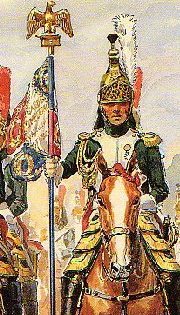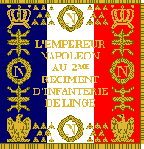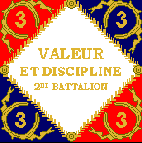
Eagle-bearer of the cavalry
of Imperial Guard, by Rousselot


Officer Jozef Zaluski of the Old Guard lancers [Polish]
was limitlessly confident in Napoleon's genius:
"We could have been asked to conquer the moon,
and we'd have responded with Forward, march !"
1. Cavalry of Imperial Guard.
Heavy Cavalry
2. Horse Grenadiers and Élite Gendarmes
3. Dragoons
Light Cavalry
4. Chasseurs and Mamelukes.
5. Polish Lancers
6. 'Red Lancers'
7. Guard Scouts
8. Honor Guard

The Cavalry of Imperial Guard.
In the end of 1800 were: Napoleon enlarged these troops to two full regiments.
Recruitment
Organization
The Velites were created from conscripts with an income of 300 francs who could produce a pair of buckskin breeches, gauntlets and boots. There were 400 Velites for grenadiers and 400 for chasseurs. There were also two smaller troops: Below is diagram showing organization of regiment:
. . . . . . . . . . . . . . . . . . .
In 1806 was formed third regiment, the Guard Dragoons (Regiment de Dragons de la Garde Impériale). Some time before the campaign in 1812 in Russia the Guard was ranked into three categories: Old, Middle and Young Guard. The Old Guard enjoyed the highest prestige, in 1811 Napoleon made it clear to Berthier (chief-of-staff) "I wish it clearly understood that this priviledge doesn't apply to the 2nd Grenadiers and 2nd Chasseurs, nor to the Fusiliers (Middle Guard), voltigeurs and tirailleurs (Young Guard) nor the 2nd Lighthorse-lancers ("Red Lancers"). ... Keep this decision for your guidance alone."
Old Guard:
In 1813 the regiments consisted of 6-10 squadrons instead of 4 squadrons each. In this situation the regimental staff was enlarged. For example the staff of Regiment of Horse Grenadiers had:
Four Duty Squadrons - Napoleon's Escort
The Elba Squadron
"A squadron of Polish lancers under Chef d'Escadron Jerzmanowski and Major Roul - 125 men divided into a mounted company of 22 under Capitaine Schultz (a giant over 2.13 metres who was present at Waterloo); a dismounted company of 96 under Capitaine Balinski... There was also a group of 7 chasseurs and Mamelukes commanded by Lieutenant Seraphin (a Mameluke...) The lancers had a white standard emblazoned in crimson with the words, 'Polish Light-Horse, Napoleon Squadron' with a crowned 'N' on the reverse." (Adkin - "The Waterloo Companion" p 14)
|
Regiment of Guard Horse Grenadiers
In 1796 the Guard of Directory (Garde du Directoire) was organized and one squadron of Horse Grenadiers was raised. Soon Napoleon enlarged the troop to two and then to four squadrons. The privates wore dark blue coats and collars, white lapels and tall boots. In 1797 they received tall fur caps. In 1804 the Consular Guard became Imperial Guard. For new candidates there were strict requirements: 176 cm tall, 10 years' service, minimum 4 campaigns and citation for bravery. The legionaires were exempted from all requirements. The horse grenadiers were tall and handsome and their colonel forbade "any woman under 40 to come in and make soup for them." :-) When it came to muscle and physique, the grenadiers, man for man, could have thrown the chasseurs, Mamelukes, the Young Guard, all outdoors and walked on them.
The Horse Grenadiers became known for their austerity and haughty demeanor.
The army nicknamed them "The Giants", "The Gods" or simply "The High Heels" (from their tall boots. In 1805 at Austerlitz they defeated Tsar's Guard cavalry.
In 1807 at Eylau they stood under hellish fire from 60 Russian cannons, when their commander General Lepic noted some of his troopers ducking incoming shells. "Heads up, by God!" he cried "Those are bullets - not turds." Few moments later they charged against the Russians. (Chandler - "The Campaigns of Napoleon")
Weapons
Commanders
Elite Gendarmes
Uniforms of Elite Gendarmes (ext.link) Most often they acted in samll detachments. They were highly disciplined, ruthless - men to be feared by draft-dodgers or villians. The army nicknamed them "The Immortals" because in the early period they didn't participate in any combat. The Elite Gendarmes rode on big black horses, and were armed with straight sabers, pistols and carbines/muskets. They wore dark blue coats with red lapels, tall boots and bearskins. Their bearskins were slightly lower than Grenadiers'.
The duties of Elite Gendarmes were: In 1809 at Aspern-Essling they guarded the bridge built across Danube River and during battle they forbade passage for any but the wounded.
Commanders
|
|
Regiment of Guard Horse Chasseurs
The chasseurs wore expensive hussar-style outfits. Their gaudy red and green regalia made them one of the most colorful regiments in Europe.
The pelisse was trimmed with curled black lamb's wool and lined with white flannel. The dolmans were dark green and were worn under the pelisses. Their short Hungarian boots were fitted by the master bootmaker. These boots were pleated at the instep for comfort and trimmed with orange braids and tassels. The squadrons of Old Guard wore black fur caps called busbies or colbacks. A scarlet flamme fell over the right side of the fur cap.
In 1796 at Borghetto, Bonaparte was lunching with general Massena and Murat when the Austrian light cavalry (Hungarian hussars ?) surprised them. Bonaparte fled by climbing over a wall and lost his boot in the process. Murat and Massena followed him. This episode resulted in Bonaparte forming his escort, the Company of Guides, who were the ancestors of the chasseurs of Imperial Guard. Bonaparte described his Guides as "200 daredevils, well-mounted and brave." In 1798 they joined Bonaparte in Egypt. These dashing and swaggering men were Napoleon's escort and for this reason they became the most known troop in the entire French army. Napoleon wore uniform of colonel of this regiment They rode on 15 hands tall (149-153 cm) pictoresque bays. Some sources (Rousselot) mention bays and chestnuts. The Guard Chasseurs were armed with slightly curved sabers, pistols and carbines. The Guard Chasseurs were less precise in formation and movement than the Horse Grenadiers but they were more resorceful and dashing. They were also more flamboyant but less disciplined than the Grenadiers. Marshal Bessieres had to request them to refrain from smoking their pipes while on escort duty and to salute generals. The army nicknamed them "The Pet Children" (or rather the Spoiled Brats :-) One or two English authors call them "The Invincibles after their battle-winning charge at Austerlitz". (Summerville - "March of Death" p 51) This is an error, it was not their nickname and their charge at Austerlitz was not battle-winning. In 1805 at Austerlitz they have fought against Tsar's Guard cavalry with mixed results. In Dec 1808 at Benavente the regiment was ambushed and defeated by numerically stronger force of British and German cavalry. The Guard Chasseurs met again with the British and German cavalry at Waterloo. Repeatedly some of the chasseur squadrons rode up to within 300-400 paces of the British and German (KGL) cavalry with their "officers wearing tall, broad bearskin hats, and on several occassions some of them rode up to us, challenging the officers of our [British] regiment to single combat. As they were much stronger, the regiment could not accept the honor ..."
Requirements:
Organization
Second Regiment
Commanders
Squadron of Guard Mamelukes
In 1805 at Austerlitz the Allies had gained a healthy respect for the colorfully clad Mamelukes,
and their proud reputation within the army was assured.
In 1804 the company had: 9 officers (6 of whom are Arabs), 10 NCO (6 of whom are Arabs), 10 brigadiers (8 of whom are Arabs), 2 trumpeters and 92 privates. (source: histofig.com) In 1813 the Mameluks were reinforced with Frenchmen who were designated as '2nd Mameluks'. There were 2 companies of Mameluks, the 1st was ranked as Old Guard and the 2nd as Young Guard. The Squadron of Mameluks was attached to the Regiment of Guard Chasseurs. Uniforms of Mamelukes (ext.link)
Chefs d'Escadron:
|
1st and 3rd Regiment of Guard Lighthorse-Lancers (Polish)
French author St. Hilaire described the Polish Guard Lancers (Lighthorsemen): "Just the name of Polish lancer awakes the ideas of bravery and of military fidelity ! ... There was in the person and the manners of the Polish lancer a kind of strangeness difficult to analyze ... at first taken for German; but with the quickness of his movements, with his instinctive exuberance, one recognized that which one so precisely called the "French of North". Though the Polish lancer easily adopted the language and the practices of his new fatherland, he could not however completely forget he was the son of heroic Poland. Concurrently with him his brother in arms shone, his follower, the French Red lancer ..." In 1807 Napoleon authorized the raising of a guard regiment of Polish light horse. Napoleon gave French instructors to train the young Poles but during following reviews conducted before Napoleon, its squadrons became so entagled with one another that the Emperor made a comment "These people only know how to fight !" Two French instructors were dismissed on the spot. But these young men dramatically improved. In 1808 they captured several batteries in a frontal assault, and for this exploit Napoleon admitted them into his Old Guard. In 1813 they charged, got under artillery fire, made half-turn and crushed enemy's cavalry without losing its alignment. Only very few regiments in Europe attained the perfection of changing the formation under fire and at gallop without losing its order ! They were never defeated by any cavalry. In 1812 when during the pursuit of Cossacks one of the lancers lost his headwear, officer Jerzmanowski ordered him to go back and retrieve it to prevent the enemy from claiming any trophy taken from this regiment. It was quite unusual since many troops panicked before Cossacks and abandoned not only their baggage and weapons but also even their wounded comrades.
On April 7th 1814 Napoleon called for volunteers from his Old Guard to serve in his guard on Elba Island. The Allies allowed for 500 infantrymen, 120 cavalrymen and 120 artillerymen. Generals Petit and Pelet were soon swamped with requests. Many officers asked to serve as simple privates.
For more information about this regiment (battle record, weapons, horses, officers, and uniforms) click here
Commanders
3rd Regiment of Polish Guard Lancers (Polish)
|

2nd Regiment of Guard Lighthorse-Lancers (Dutch-French)
This regiment wore one of the most striking uniforms in Napoleonic cavalry. For this reason there are more pictures of this regiment than any other cavalry unit (well, maybe with few exceptions). The Dutch lancers wore traditional Polish style headwear (top-squared) edged in yellow with a silver badge, white plume, and yellow cords. The coat was red, horse furniture was dark blue with a yellow edge. Officers wore gold lace and cords. The lancers rode on fine chestnuts and bays. Picture of young Dutchman in his red outfit. (ext.link)
In 1812 the Red Lancers suffered in Russia where the Cossacks hunted them mercilessly. (The bearded warriors nicknamed the Dutchmen "Red Boys") Paul Britten-Austin writes that the Dutchmen are "too phlegmatic" for the little warfare. Austin writes: "Approaching stealthily, Cossacks nevertheless (again) carry off the Dutch regiment's outpost picket. And again 'only one man escaped flat out at a gallop and brought the news to our camp.
Even an hour and a half's pursuit couldn't catch up with the Cossacks.'
In 1813 this regiment was rebuilt with volunteers and King Joseph's (Napoleon's brother) guard. Many of these men were veterans. Some sources give the first 5 squadrons as Old Guard and majority Dutch. The other 5 squadrons were ranked as Young Guard and were recruited in part from the municipal cavalry of the Guard of Paris. Other sources give 4 squadrons of Old Guard and 6 of Young Guard. It was a very strong regiment and participated in numerous combats. In 1815 Napoleon wrote: "As soon as possible the Red Lancers must be increased to 3 regiments..." This however didn't happen, the time was too short. In 1815 was only one regiment as they lacked men and accepted cavalrymen from different sources: Royal Corps, retirement, Young Guard and even shorter men of the horse grenadiers. During retreat after Waterloo they routed British cavalry.
Colonels:
|

1st, 2nd and 3rd Eclaireurs Regiment
'On December 9, 1813, the Guard cavalry underwent further reorganization with the creation of three eclaireur or scout regiments, attached to the Grenadiers, Dragoons and 1st Lancer regiments of the French Imperial Guard respectively. Napoleon had in mind a French counterpart to the Russian cossacks that had harrassed so effectively the French flanks during the retreat from Moscow. Each regiment of eclaireurs had 4 squadrons of 250 men each (theoretically). The privates of squadrons of Old Guard wore uniform of hussar pattern, green dolman with white laces and braid. Those of Young Guard wore a simple green a la Kinski coat. These scouts were armed with lances and sabers (in first rank) and carbine and saber (in second rank). The eclaireurs were disbanded already in June 1814. Uniforms of Eclaireurs and Honor Guard (ext.link)
1er Regiment d’Eclaireurs
2e Regiment d’Eclaireurs
3e Regiment d’Eclaireurs
|
|

1st, 2nd and 3rd Honor Guard Regiment In 1813 there were 15.000 volunteers with 20.000 horses, mounted and equipped at their own expense. These 20-26 years old men came mainly from noble and wealthy families but were hardly enthusiastic for military service and soon many deserted. They formed new regiments named Life Guard but because of the desertions it was changed to Honor Guard. The rest of the army called them "the Hostages". :-) The privates wore uniform of hussar pattern, green dolman and pelisse with white braid, edging and laces. The collar and cuffs were scarlet collar with white edging. Crimson sash with green sliding loops and cord. Silver buttons. The breeches were scarlet breeches with white lace. Short black hussar boots. The shako was scarlet with silver eagle, white top band, cords and flounders. Green plume with blue top over a pompon in squadron color inserted in a tricolour cockade. The chinstrap were silver. Green portemanteau with white edge and regimental number. Uniforms of Eclaireurs and Honor Guard (ext.link) The privates were armed with light cavalry sabers and carbines.
Casualties suffered in 1814 Campaign:
Colonels:
|

Sources and Links.
Elting - "Swords around a Throne: Napoleon's Grande Armée"
Lachouque (Anne S. K. Brown) - "The Anatomy of Glory: Napoleon and his Guard"
Chlapowski - "Memoirs of a Polish Lancer" transl. by Tim Simmons
Rousselot, text by Edward Ryan - "Napoleon's Elite Cavalry"
Mansel - "The Eagle in Splendour: Napoleon I and His Court"
Six - "Dictionaire biographique des generaux et amiraux..."
Artillery of the Imperial Guard
Infantry of the Imperial Guard